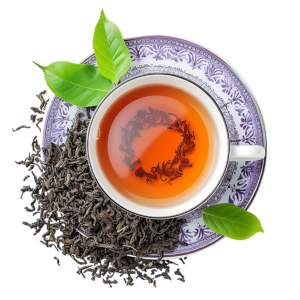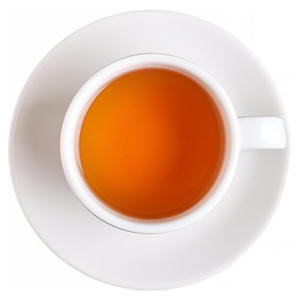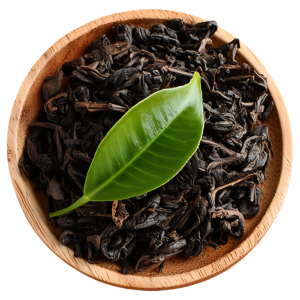WHOLESALE TEA
Black Tea – Listed below are several grades of tea, mostly from the “Orange Pekoe” (OP) family, along with their respective leaf sizes and qualities. These grades are commonly used in the tea industry to describe the size and quality of tea leaves. Each of these classifications serves a specific purpose, especially when blending tea or evaluating its quality. This grading system helps tea producers and traders classify and describe tea to customers based on their leaf size, strength, and appearance.
- BOP (Broken Orange Pekoe): Small or broken leaf pieces.
- BOPF (Broken Orange Pekoe Fannings): Smaller than BOP, broken leaf, slightly larger than dust.
- OP (Orange Pekoe): Same style but smaller than OPA.
- FBOP (Flowery Broken Orange Pekoe): Same as BOP but slightly larger and contains a few tips (young leaves).
- Pekoe: Twisted and coarse leaves.
- OPA (Orange Pekoe ‘A’): High-quality tea with large, slightly open leaf pieces.
- OP1 (Orange Pekoe One): Wiry and slightly larger than OP.
- BOP1 (Broken Orange Pekoe One): Small and wiry, smaller than OP1.
- FBOP1 (Flowery Broken Orange Pekoe One): Slightly smaller than BOP1.
- FBOPF (Flowery Broken Orange Pekoe Fannings): Similar to BOP but firmer leaves with a few tips.
- FBOPF1 (Flowery Broken Orange Pekoe Fanning’s One): Similar to BOPF but firmer and with a little more tips.
- FBOPFSP (Flowery Broken Orange Pekoe Fannings Special): Firmer, with more black leaf and better tips; higher price.
- FBOPFEXSP (Flowery Broken Orange Pekoe Fannings Extra Special): Similar to FBOPF1 but with more firm black leaf and excellent tips; more expensive.
- D (Dust): Smallest particles, brownish powder, usually lower quality.
- D1 (Dust 1): Smaller than Fanning’s, fine powdery leaves.
White Tea
White tea is made from the young leaves and buds of the tea plant, often minimally processed to preserve its delicate flavor. Here are two types of white tea:
Silver Tips: These are small, unopened buds of the tea plant, typically a very light, silver or white color. They are considered the highest grade of white tea, known for their subtle, sweet, and floral flavor.
Golden Tips: Similar to silver tips, but these buds have a golden hue mixed with white. These are also high-quality but often slightly sweeter and more flavorful than silver tips.
Green Tea
These grades reflect the processing methods, size, and appearance of the leaves, and each type results in different flavor characteristics.
Green Tea Grades:
- CH (Chunmee): A type of green tea with curled, twisted leaves. It’s smaller than GP and often has a slightly tangy, floral flavor.
- GP1 (Gun Powder 1): Twisted and coarse leaves, similar to Pekoe but with a distinct green color. This variety has a slightly smoky flavor due to its processing.
- GP2 (Gun Powder 2): Similar to GP1, but the leaves are a bit more open and slightly larger.
- GP Sp (Gun Powder Special): This grade has larger, more tightly curled leaves compared to CH, with a more pronounced bloom in the curl. It’s considered higher quality due to its appearance and flavor.
- GC (Green Curl): Opened, coarse leaves with a darker green color. This type of green tea can have a deeper flavor profile and may be slightly more robust than other green teas.
- SW (Sowmee): Even and neat, with opened leaves. These leaves tend to produce a smooth, balanced flavor and are often used for high-quality green teas.
- Sencha: A very popular Japanese green tea, characterized by tiny, needle-shaped, dark green leaves. It has a fresh, grassy, and slightly umami flavor.
- GTFF (Green Tea Flowery Fannings): Similar to BOPF (Broken Orange Pekoe Fannings), but with green leaves and containing a few tips. It’s a slightly lower-grade, fine-leaf tea that is often used in tea bags.
- GTFF1 (Green Tea Flowery Fannings 1): Slightly larger than GTFF, with a better leaf appearance and a more refined flavor.
- GRP (Green Tea Powder): A finely powdered green tea, usually the last part of the processing stage. This powder is used to make matcha or other powdered teas and has a rich, intense flavor.
Each of these grades has distinct characteristics and uses, depending on the region of origin, how the leaves are processed, and the desired flavor profile. The tighter, more curled teas (like Gun Powder) often have a more robust flavor, while the flatter, more open leaves (like Sowmee) tend to have a gentler, more delicate taste.


